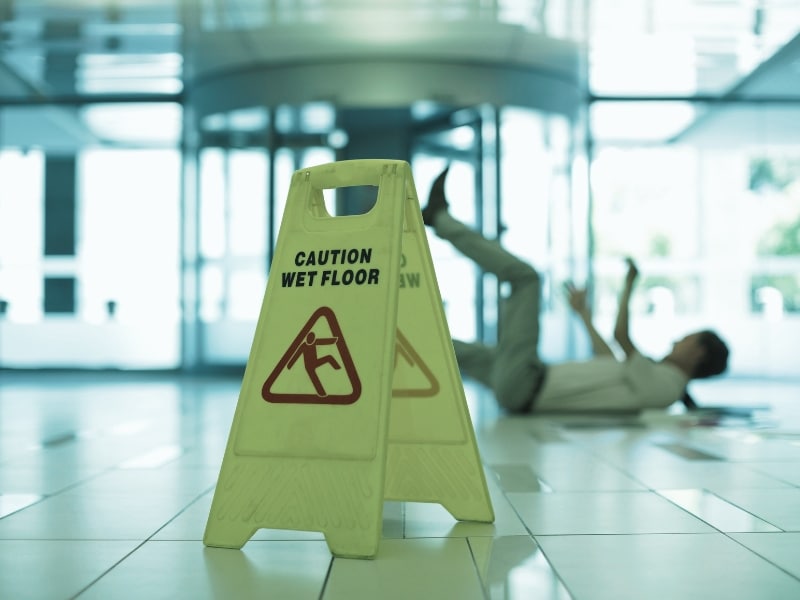How to Win a Slip and Fall Case in Illinois

To win a slip-and-fall case in Illinois, you’ll need to establish the owner of the property’s liability for the hazardous condition that led to your accident and injuries. You’ll need to prove that the owner knew or should have known about unsafe conditions on the property and how the condition caused your injuries. Many factors are involved in proving and winning a slip-and-fall case. Read on to learn more about these factors and how to win a slip and fall case.

Table of Contents
How to Win a Slip and Fall Case
Slip and fall accidents are a leading cause of brain injuries. They also commonly cause soft tissue injuries, sprained wrists and ankles, fractures, and spinal cord injuries. If you’re injured on someone else’s property due to a hazardous condition, you can file a slip and fall claim or lawsuit against the owner, manager, or occupier of the property, which may include a business, private homeowner, or government entity, to recover damages.
Winning a slip-and-fall case requires you to be conversant with the state laws that apply to your case and the legal elements needed to prove your case.
Slip and Fall Laws in Illinois
The laws that affect your ability to recover compensation in a slip-and-fall case in Illinois include the following:
Illinois Premises Liability Act
The Illinois Premises Liability Act protects people on someone else’s land. It specifies the legal duty that a property owner or occupier owes to individuals on the property. The Act also lays down the conditions under which a property owner or occupier may be held liable for the dangerous conditions on the land.
When you’re on someone else’s property, you can be a licensee, invitee, or trespasser. Invitees benefit the property owner economically when they enter the property. They include spectators, customers, independent contractors, and job applicants. Licensees are people who come to a property for their own benefit rather than the owner’s interest, such as social guests. Trespassers enter another person’s land without that person’s invitation or permission.
The Premises Liability Act imposes on the property occupier or owner the duty to provide reasonable care to invitees and licensees. Property owners or occupiers do not owe adult trespassers a duty of care apart from refraining from inflicting willful or careless injuries on the trespassers.
According to the Act, property owners can be held liable for dangerous conditions like slippery surfaces if they:
- Knew or should have known of the dangerous condition and the unreasonable injury risk it posed to people
- Would reasonably expect an invitee or licensee not to discover the danger
- They failed to use reasonable care to protect the invitees and licensees from the condition
Modified Comparative Negligence Rule
Illinois follows a modified comparative negligence system. The potential damages award you could receive will be reduced according to your percentage of fault for the slip-and-fall accident. Suppose your damages add up to $50,000, and you’re found to be 20% responsible for your accident. In that case, you’ll only recover $40,000. You can’t recover any compensation if you’re considered more than 50% at fault for the accident because of your own negligence.
Talking on your phone, texting, wearing inappropriate footwear, ignoring warning signs, and the hazard being open and obvious are some arguments that property owners may present to shift some amount of responsibility for the slip and fall to you. Slip-and-fall lawyers help maximize your compensation by arguing down your percentage of fault.
Natural Accumulation
Illinois laws protect owners from liability in slip-and-fall accidents involving snow and ice under the national accumulation rule. Under the rule, property owners have no obligation to clear snow and ice that has accumulated naturally from their premises.
Nevertheless, property owners and business operators can be liable for a slip-and-fall accident on snow and ice if you can prove that they aggravated the natural condition or caused it to become unnatural. For example, the owner might have shoveled natural accumulations of snow and piled them up on the entranceway, through which you had to walk to access or exit the premises. A snow removal company may also clear the parking lot and pile the snow elsewhere, which would be an unnatural accumulation.
Property owners and business operators may also be liable if snow and ice accumulation is inherently unnatural. For instance, poor building design or maintenance may cause an unnatural accumulation of ice and snow.
Statute of Limitations
Statutes of limitations are time limits for filing a claim following your slip-and-fall accident. You may be barred from pursuing the claim if you don’t meet the filing deadline.
What Is the Slip and Fall Statute of Limitations in Illinois?
Under Illinois law, slip-and-fall victims typically have two years from the date of the incident to file their case. The time limit may be extended for accidents involving children, latent injuries, and fraud. A slip and fall lawyer will help you determine the limitations period that applies to your situation.
Proving a Slip and Fall Case
To make a successful slip-and-fall claim, you’ll need to prove the elements below.
Proving Duty
Noting that a property owner needed to keep the premises safe could help prove the owner owed you a duty of care. Nevertheless, your status on the property when you suffered the slip-and-fall injury also matters. If the site is open to the public, or you have been invited, then the property owner owes you a greater legal duty of care. That means the owner has to take reasonable precautionary measures to ensure the area is safe.
In Illinois, there’s no difference in the duty of care owed to invitees and licensees. Complications could arise if you didn’t enter the property lawfully or were breaking the law when the slip-and-fall accident occurred. In most cases, owners don’t owe adult trespassers a duty of care. However, the owner could be held liable for a trespasser’s injury if he or she knew of the trespasser’s presence and the dangerous condition on the property and didn’t take the necessary steps to prevent the accident and injuries.
Proving Hazard
You need to show that a hazardous condition existed somewhere on the property at the time you got injured for you to prevail in your slip-and-fall case. A hazardous condition is a situation that poses a foreseeable injury risk. Such conditions include common causes of slip and fall accidents like:
- Liquid spilled on the floor
- Loose or damaged floorboard or carpeting
- Uneven walkways and sidewalks
- Defective stairways
- Loose, broken, or missing handrails
- Poor lighting conditions
Having photos or other documentation of the dangerous condition is crucial.
Notice of the Hazard
You must also show that the liable party had notice of the defect or hazard before you were hurt in the slip-and-fall accident. There are two ways to prove notice of the hazardous condition:
Actual Notice
This type of notice arises when the property owner or occupier knew of the hazardous condition that led to your injury. The owner or occupier may have seen the hazard, created it, or been informed about it. For example, a grocery store would have actual notice of a dangerous condition if a store employee saw a hazard, such as a spill, but ignored it. Similarly, a building owner would have actual notice if several complaints had been made about broken or missing handrails, but the owner didn’t fix the problem.
Constructive Notice
In many cases, the responsible parties claim they didn’t know about the dangerous condition before the slip-and-fall accident. In such cases, the notice element can be proven through constructive notice.
Constructive notice means an owner or occupier should have known of the hazard if he or she had exercised reasonable diligence and care in the given circumstances, for example, due to the condition’s conspicuous nature or the length of time the hazard or defect had existed. You could establish constructive negligence in a case where food or a liquid that fell onto the floor of a restaurant had been there for more than 15 minutes, or the restaurant staff should have seen the danger and reacted to it if they had inspected the walkways.
Proving Fault
Furthermore, you will also need to show that the injuries you suffered were attributable to the hazardous condition. You can prove this element by showing the property owner or occupier failed in the obligation to protect you from a dangerous condition, and that failure caused your injury. In other words, the property owner or occupier acted negligently, and you suffered harm because of the negligence.
Suppose you fractured your hip at a restaurant due to food or liquid on the floor after the staff failed to clean up the floor area. You could use the restaurant’s policies and procedures regarding inspections or cleaning to show that the employees were negligent by failing to follow the guidelines on cleaning the floor areas regularly, and you suffered the injury due to their negligence.
Act Fast
It’s best to act quickly after sustaining an injury in a slip-and-fall accident. Conducting thorough investigations early enough can be the difference between successfully pursuing a slip-and-fall claim and losing your case. A slip-and-fall lawyer will fully investigate your case and promptly take the necessary steps to ensure evidence is preserved. Evidence like surveillance video is usually recycled or deleted after a certain period, so your lawyer must request it soon after your accident to ensure it’s preserved.
Details, essential for how to win a slip and fall case, are commonly misplaced or forgotten over time. The longer you wait before taking action after your accident, the harder it becomes to locate individual witnesses and key evidence. Losing evidence can be detrimental to your slip-and-fall case.



